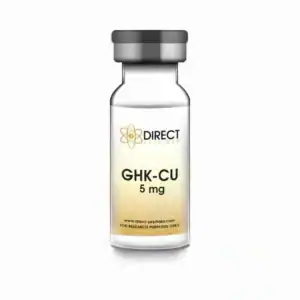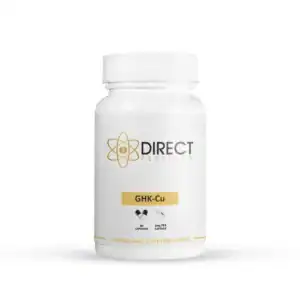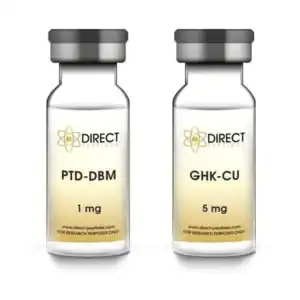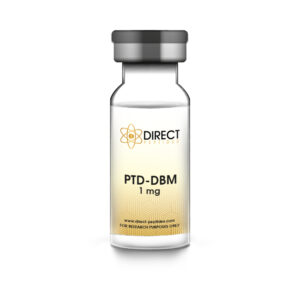Peptide therapy is an exciting new area of medical science. It shows great promise for treating many diseases with precision and fewer side effects. Peptides are short chains of amino acids that naturally occur in the body and play important roles in various functions. By using peptides for therapy, we can work with the body’s natural processes to improve health.
Two peptides, PTD-DBM and GHK-Cu, have recently gained attention for their potential in treating hair loss, improving hair density, enhancing healthy hair growth, and enhancing hair strength. PTD-DBM is a cell-penetrating peptide. It may help fight neurodegenerative diseases and cancer by stopping harmful cell death.
On the other hand, GHK-Cu, also known as Copper tripeptide, is known for its anti-aging, wound healing, and anti-inflammatory effects. These peptides work well together and show great potential in improving hair health and overall health and well-being. This paper will explore their roles in peptide therapy in more detail.
Peptide stack PTD-DBM and GHK-Cu is available to buy online from Direct Peptides Indonesia, a trusted supplier of premium grade peptides worldwide.
PTD-DBM and GHK-Cu are peptides used in skincare. PTD-DBM helps active ingredients reach deeper layers of the skin. Meanwhile, GHK-Cu boosts collagen production and promotes skin regeneration. Together, these peptides improve the effectiveness of skincare products, providing anti-aging benefits and enhancing overall skin health.
PTD-DBM, or Protein Transduction Domain – Direct Binding Motif, is a special peptide that can penetrate cell membranes. It was discovered through peptide screenings targeting the WNT pathway. This discovery has led to new possibilities for therapies, especially for delivering drugs inside cells, where traditional methods face challenges.
Buy PTD-DBM peptides from Direct Peptides Indonesia, available in vials, pre-mixed pens and nasals.
The key feature of PTD-DBM is its ability to enter cells and bind directly to target proteins. This action prevents these proteins from interacting with others, which is crucial for hair follicle health and hair follicle development in affected areas of scalp, particularly in conditions like androgenetic alopecia.
By disrupting harmful cellular processes, PTD-DBM can offer therapeutic benefits similar to those of methyl vanillate.
PTD-DBM has gained attention for its role in slowing the progression of neurodegenerative diseases and cancer. It works by blocking cell-death pathways, which could promote hair regrowth and also treat conditions linked to abnormal cell growth.
Additionally, it has shown amazing hair restoration effects when paired with peptides like GHK-Cu, PTD-DBM’s effectiveness increases, unlocking new possibilities in peptide therapy.
GHK-Cu (Glycyl-L-Histidyl-L-Lysine-Copper) is a natural copper compound made up of three amino acids and a copper ion. This simple structure gives it powerful healing properties. GHK-Cu plays a key role in wound healing, tissue repair, and hair loss treatment. It is also a strong anti-inflammatory agent, making it useful for many health problems.
In skin care, GHK-Cu is widely known for its anti-ageing effects. It helps the skin produce more collagen, which reduces wrinkles and improves elasticity. This makes it a versatile and valuable ingredient for improving health and appearance.
GHK-Cu Peptides for sale online from Direct Peptides Indonesia, available in vials, nasals and pre-mixed pens to provide flexibility in your research.
GHK-Cu is a powerful peptide with many uses in therapy. Its ability to heal wounds and repair skin makes it valuable for treatments like skin rejuvenation and hair growth. Additional information indicates that it also helps reduce chronic inflammation and age-related issues because of its anti-inflammatory and antioxidant effects. This peptide promotes cell growth and movement, making it useful in regenerative medicine and cosmetic treatments.
An exciting development in peptide therapy is combining GHK-Cu with other peptides, such as PTD-DBM. GHK-Cu helps regenerate tissues, while PTD-DBM prevents cell death. Together, they could bring major breakthroughs in treating various diseases.
Explore Peptide Supplies at Direct Peptides Indonesia for all your reconstitution requirements.
To understand how PTD-DBM and GHK-Cu work together, we need to explore their combined effects. These peptides complement each other, with the strengths of one boosting the impact of the other. Together, they create a stronger therapeutic effect.
When used together, PTD-DBM and GHK-Cu show a powerful synergy. Each works in unique but complementary ways:
When combined, these peptides work better together than alone. Their partnership opens doors to new ways of treating and preventing diseases.
The combination of PTD-DBM and GHK-Cu creates a powerful tool for fighting many diseases.
In short, PTD-DBM and GHK-Cu work better as a team. Their combined effects could transform peptide therapy and improve treatments for many health issues.
There is growing evidence that PTD-DBM and GHK-Cu work better together than on their own. Indonesia Research highlights this synergy and points to the benefits it offers in peptide therapy.
One study looked at using PTD-DBM and GHK-Cu together with valproic acid to treat neurodegenerative diseases. The findings showed that this combination reduced neural cell death more effectively. This suggests it could help slow down neurodegeneration.
Another study explored how PTD-DBM and GHK-Cu work together to heal wounds. The results revealed that wounds healed faster when treated with both peptides compared to either one used alone.
The findings from these studies provide invaluable insights into the combined therapeutic potential of PTD-DBM and GHK-Cu.
Indonesia Research shows that combining PTD-DBM and GHK-Cu with other treatments increases their effectiveness. This discovery could change how we treat diseases, especially in areas like neurodegenerative disorders and wound healing.
The powerful combination of PTD-DBM and GHK-Cu could help manage a wide range of diseases. This opens the door to new treatments that can be customized for each patient’s unique needs.
Together, PTD-DBM and GHK-Cu might improve anti-ageing therapies. This could lead to better solutions for age-related issues, like skin ageing and other degenerative changes.
In conclusion, the synergy between PTD-DBM and GHK-Cu shows great promise in peptide therapy. It could pave the way for more effective and personalized treatments in the future.
Healthcare is moving toward more personalized and precise treatments. Using PTD-DBM and GHK-Cu together may open new doors in peptide therapy. Studies show that these peptides work well together, helping with tasks like stopping cell death and repairing tissues.
This could lead to better ways to treat diseases like cancer, degenerative disorders, and issues related to aging. Future research should focus on boosting this synergy, improving how these peptides are given, and looking into new diseases where they could help.
The combined use of PTD-DBM and GHK-Cu shows how powerful peptide stacks can be in healthcare. As we learn more about how cells work and how diseases develop, combining peptides may become a key part of medical care.
This method uses the strengths of each peptide and their teamwork to offer better, more tailored, and possibly less invasive treatments. Exploring peptide stacks is an exciting step forward in medical science.
[1] Pickart L, Vasquez-Soltero JM, Margolina A. The human tripeptide GHK-Cu in prevention of oxidative stress and degenerative conditions of aging: implications for cognitive health. Oxid Med Cell Longev. 2012;2012:324832.
[2] Hong Y, Downey T, Eu KW, Koh PK, Cheah PY. A ‘metastasis-prone’ signature for early-stage mismatch-repair proficient sporadic colorectal cancer patients and its implications for possible therapeutics. Clin Exp Metastasis. 2010 Feb;27(2):83-90.
[3] Wang Y, Li X, Zhao W, Gao ZZ, Zheng MJ, Pang YL, Chen ZY. [Protein expressions of matrix metalloproteinase-9 and its inhibitor and their ratio changes in wound healing of patients with stages Ⅲ and Ⅳ pressure ulcers]. Zhonghua Shao Shang Za Zhi. 2019 Oct 20;35(10):746-751.
[4] Campbell Y, Fantacone ML, Gombart AF. Regulation of antimicrobial peptide gene expression by nutrients and by-products of microbial metabolism. Eur J Nutr. 2012 Dec;51(8):899-907.
[5] Dou Y, Lee A, Zhu L, Morton J, Ladiges W. The potential of GHK as an anti-aging peptide. Aging Pathobiol Ther. 2020 Mar 27;2(1):58-61.
[6] Pickart L, Margolina A. Regenerative and Protective Actions of the GHK-Cu Peptide in the Light of the New Gene Data. Int J Mol Sci. 2018 Jul 7;19(7):1987.

TWIN PACKS
TWIN PACKS
TWIN PACKS
TWIN PACKS
GHK-Cu Copper Peptide Vial
£15.00 – £76.48Price range: £15.00 through £76.48 Select options This product has multiple variants. The options may be chosen on the product page
GHK-Cu Capsules
£63.33 Add to cart
PTD-DBM GHK-Cu Peptide Stack
£30.50 – £39.48Price range: £30.50 through £39.48 Select options This product has multiple variants. The options may be chosen on the product page
PTD-DBM Peptide Vial
£18.89 – £27.87Price range: £18.89 through £27.87 Select options This product has multiple variants. The options may be chosen on the product pageCheck out the full range of peptide stacks from Direct Peptides today!
ALL CONTENT AND PRODUCT INFORMATION AVAILABLE ON THIS WEBSITE IS FOR EDUCATIONAL PURPOSES ONLY.
DISCLAIMER: These products are intended solely as a research chemical only. This classification allows for their use only for research development and laboratory studies. The information available on our Indonesia Direct Peptides website: https://indonesia.direct-peptides.com is provided for educational purposes only. These products are not for human or animal use or consumption in any manner. Handling of these products should be limited to suitably qualified professionals. They are not to be classified as a drug, food, cosmetic, or medicinal product and must not be mislabelled or used as such.